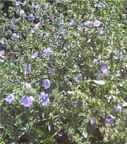
| HOME --> All Plants and Seeds INDEX --> Vegetables INDEX --> Chicory | |
| Plant and Seed Mobile Friendly Index |

Wild Chicory (Anchicoria, Barbe de Capucin, Blaue Wegwarte, Blue Sailors, Kasni, Kiku-Niga-Na, Succory, Zikorifa, Chicon) Cichorium intybus Full sun; plant height: 2-4ft.
| #1387 Packet $6.50 Approximately 100 seeds |
|
| #B4z-1387 Bulk seed 4oz $16.89 |
|
| #B1-1387 Bulk seed 1 lb. $29.25 |
|
This member of the Aster family, Asteracaea, is a Euoropean
native and an is a extremely useful plant that has established
itself all over North America. It is easily grown from
seed (ususally as an annual, though it is a perennial
plant). The deep tap root makes it unsuitable for
transplanting, so it is best to plant it where it is to
remain. The plant contains a milky sap and the lavender-blue
daisylike blooms remain on the plant for only a single day.
Propagation is by sowing seed in fall or spring
and is best done as a direct sowing into a prepared space.
Prepare soil in an area that receives at least 8 hours of sunlight
per day. Dig the area, then rake the ground to remove all
large clods, stones and debris. Sow 1 seed per inch in rows
18-24 inches apart, then step on the seed to cover. One can
also broadcast seed over the prepared area, then walk over the
seed area to press it into the soil. Keep the seed area
moist until seedlings emerge, then provide water during dry spells
until they are established.
In the United States, during the Civil War and again during WWII, chicory was served as a coffee substitute - the older the root, the more bitter the drink. Leaves are eaten as a salad green, preferably in winter, when a great deal of the bitterness is gone from the plant. Blooms are eaten in salads, and roots are cooked and eaten like parsnips. The plant contains a large proportion of inulin (a starch undigestible to humans), which renders it useful in the production of alchohol.
HARVEST: Pick leaves at any time once the
plant is established. Dig roots in the second season as
needed.
SEED SPECS: Average 26,625 seeds per
ounce; Seeding Rate: 1oz per 525 sq ft, 5lbs
per acre
ORDER EARLY!
See TERMS
Back to VARIETY INDEX
Terms HOME
![]() If you have
arrived in someone else's frame, or can not see all of the other
information available on richfarmgarden.com Click on logo to enter
from beginning
If you have
arrived in someone else's frame, or can not see all of the other
information available on richfarmgarden.com Click on logo to enter
from beginning